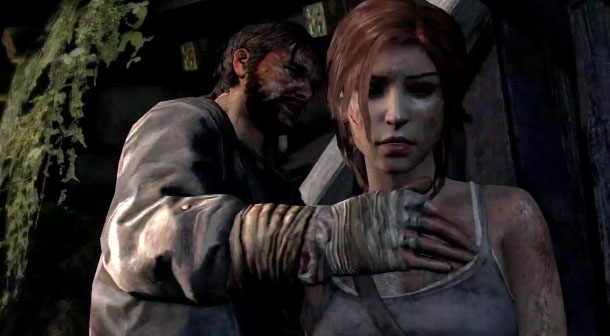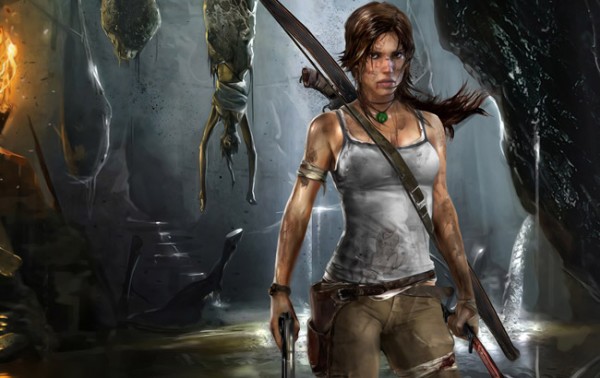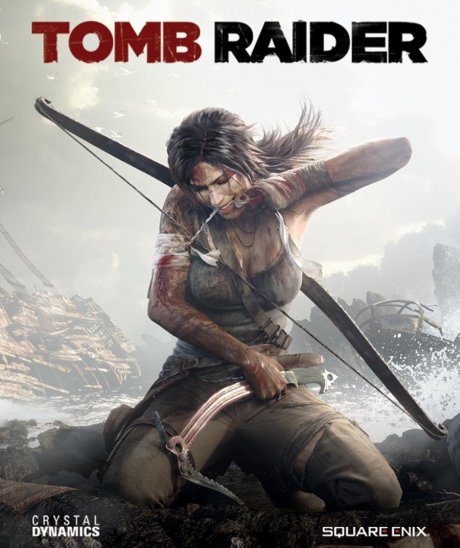A woman hangs upside down from the ceiling of a creepy cave. She awakens, groggy, next to what looks like a caccooned corpse and, terrified, fights her way free. The cave is full of candles and a splayed corpse, displayed ritually in what looks like a shrine. Disoriented, she fights her way to escape only to discover that the island is full of more horrors than she can possibly imagine.
Sound like the set-up for the latest torture porn escapade ala Wrong Turn or Saw? No way, game fans. This is premise for the newest installment of the Tomb Raider franchise, now with 100% more gritty action, claustrophobic caves and, oh yes, burly male kidnappers. We travel back into Lara’s past in this gorgeously rendered prequel to answer the question of just how little Lady Croft became the world-renowned Tomb Raider.
The answer, it seems, is through a little healthy application of torture porn tropes and Hunger Games-style rip-offs. Check it out!
It’s pretty obvious that from this start, this new Tomb Raider video game was out to revamp and, in many ways, salvage the character of Lara Croft. The series has taken a lot of flack for Lara’s pretty obvious fan service and the character’s redesign deals with Lara’s reality-defying physical proportions by slimming down Lara’s curves to make her less busty. This is a younger Lara, designed specifically to inspire gamers to want to root for her as a female protagonist rather than as just a sexy icon. It sure helps that she looks a hell of a lot like Katniss Everdeen these days, right down to the bow and arrow action, but we’ll ignore the attempts to cash in on other franchises. This new Lara is coded to inspire empathy rather than just hormones in players—you’re supposed to want to help get her through the trials and tribulations of the new game. And she could use the help, considering the designers of this game seem intent on putting Lara through the horror movie ringer to evolve her into a tough female protagonist. This includes throwing in some creepy kidnappers who grab Lara and her best friend and, in classic up the ante fashion, attempt to rape our heroine.
You read that correctly. Because overcoming the trials and tribulations of a shipwreck on a deserted island isn’t enough to prove someone a badass, there’s just got to be some kidnapping rapists to round out the package.
The game centers around Lara’s attempts to survive the rigors of the island with a whole lot of panting and screaming in the mix (because that’s what women do all the time while trying to survive, waste their oxygen on screeching like howler monkeys), all while out to rescue her best friend from some unknown filthy kidnappers. This is a noble cause enough, but things get so much worse when Lara is grabbed and one of the guys gets a little hands-on. Faster than you can say “things just got real” Lara’s picked up a gun for the first time to defend herself and is now well on her way to becoming the gun-wielding badass we recognize. If that feels a little exploitative to anyone else, you’re right on board with my reaction to the plot choice and the trailer as a whole.

The use of rape in the evolution of tough female protagonists is a touchy thing. Far too many creators believe that using that kind of assault in a backstory is a quick and easy way to give a female character something heinous for her to overcome. Want to prove a bad guy is the most evil, horrific creature to crawl the earth? Write in a rape scene and they are instantly coded as The Worst Ever for audiences. It’s an easy fall-back for upping the stakes for a female character while giving a moment for audiences to point to as a pivotal turning point for the heroine. There, they can say, is where she didn’t just get mad, she got even. But is that inclusion necessary? Isn’t it enough that she’s shipwrecked, nearly died in a cave-in, and her best friend is kidnapped by unknown men who are after her? Nope, Lara learns to pick up a gun and defend herself as her first step as a gunslinging heroine to defend herself against rape. Of course.
Game designer Ron Rosenberg is quoted as stating that the rewrite for this version of Lara is an attempt to make her someone you’d root for more than a male character. He indicates that the process of building up Lara into a hero involves breaking her down first and making her suffer, while attempting to inspire feelings of protectiveness in the audience rather than character identification. “She is literally turned into a cornered animal,” Rosenberg states in a recent Kotaku article. “It’s a huge step in her evolution: she’s forced to either fight back or die.”
So the attempt to evolve her as a character outside of a sexualized icon has centered around turning her into a cornered animal? That’s the strategy for humanizing her as a character? To paraphrase a movie once: I do not think this means what you think it means.

A good test for whether this part is necessary is to remove Lara from the story and substitute her with Drake from Uncharted. The rest of the game trailer certainly has a very Uncharted-esque feel to it, which speaks volumes for the designers knowing what treasure hunter game titles are selling. But if a young Drake was tossed into this plot line, would the writers be so quick to include an attempted rape as a way to further the character? Probably not. And that flunks this plot as a vehicle for gender-equal character evolution.

Overall, the upcoming Tomb Raider looks to be a visually stunning dark action-adventure. But if you were looking for some treasure hunting, animal fighting, butt-kicking Croft action in this prequel, it seems most of that has taken a backseat to a jungle gauntlet set to forge Lara from screeching co-ed into stoic badass. Too bad the road they take is half The Last House on the Left and half Taken (if Taken was set on the island from Lost.) I applaud the attempt at renovating the character with a less sexualized image, but I think a very important point about creating Lara as a person has been missed in their rush to write her as a woman, and in the process they’ve fallen into the mess of one of the most overused and distasteful cliches in female protagonist history. Tropes firmly in place, I’m sure this game is going to do very well, but the creators have got a lot to learn if they expect that they’ve improved Lara’s stereotyped status.
Shoshana Kessock is a comics fan, photographer, game developer, LARPer and all around geek girl. She’s the creator of Phoenix Outlaw Productions and ReImaginedReality.com










